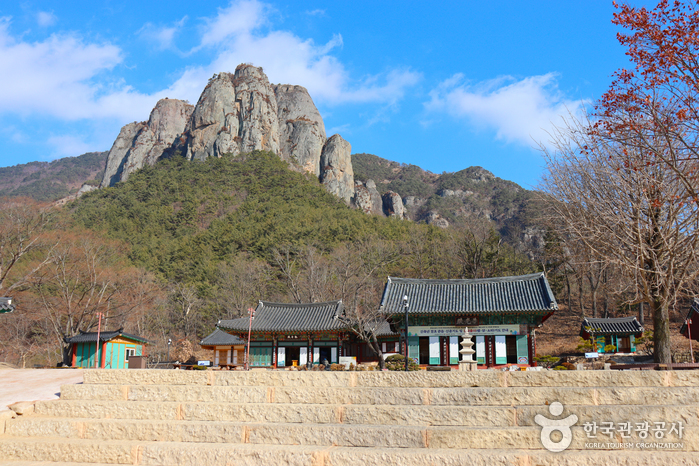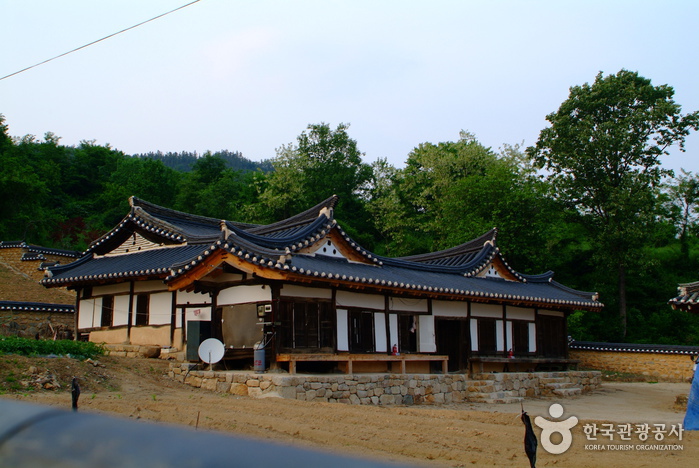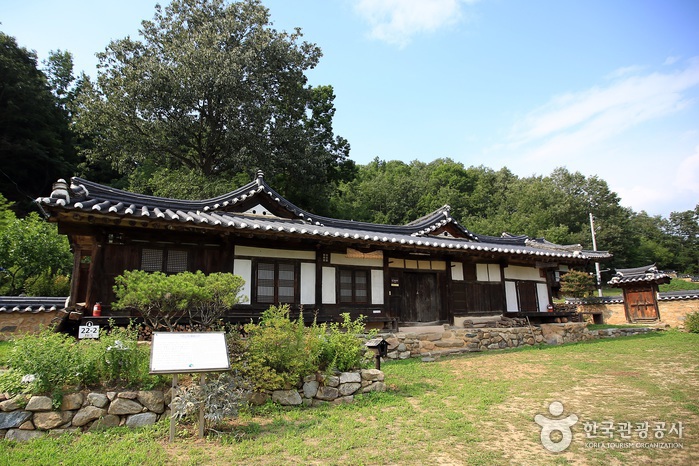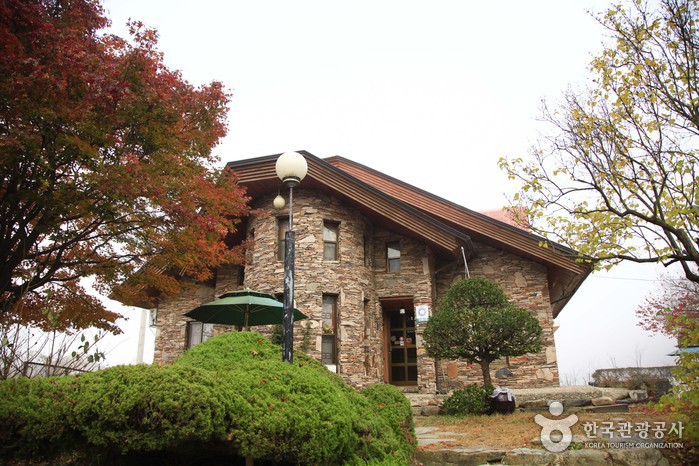House of Changsil [Korea Quality] / 창실고택 [한국관광 품질인증]
5.7 Km 11157 2023-12-06
39 , Songsogotaek-gil, Cheongsong-gun, Gyeongsangbuk-do
+82-10-5100-3684
Changsil Old House is a courtyard hanok in Cheongsong-gun, Gyeongsangbuk-do. It was built in 1917 by Sim Ho-taek of Songso as a home for his younger brother. The anchae (women’s house) and the sarangchae (men’s house) are arranged side by side, with the connected library and storeroom between them. Just inside the gate is a haengnangchae (servants’ quarters), and there is also a thatched hanok which is currently being rented out as a red clay room.
Juwangsan National Park (주왕산국립공원)
6.6 Km 52577 2023-03-13
169-7, Gongwon-gil, Cheongsong-gun, Gyeongsangbuk-do
+82-54-870-5300
Juwangsan Mountain (alt. 720.6 m) is located in the Baekdudaegan Mountain Range, the backbone of the Korean peninsula. The mountain features deep valleys and many sheer rock cliffs to make it the third-largest rocky mountain in the country. Juwangsan Mountain was recognized as a tourist attraction on May 30, 1972, and became the 12th national park a few years later on March 30, 1976. The park is relatively small, filling in an area of just 105.582 ㎢ but it is great for a leisure walk with walking trails along the valleys up to waterfalls.
Juwangsan Mountain was called Seokbyeongsan Mountain during the Silla dynasty due to the many stone peaks jutting out but has been called Juwangsan Mountain since the Unified Silla period. In addition to these tall rocky peaks, Juwangsan National Park also includes four waterfalls, caves, Daejeonsa Temple, and other attractions for a comprehensive tourist site.
Daejeonsa Temple (대전사)
6.9 Km 13481 2023-04-17
226, Gongwon-gil, Cheongsong-gun, Gyeongsangbuk-do
+82-54-873-2908
Daejeonsa Temple is said to have been built by Great Monk Uisang in the 12th year of King Munmu’s reign (672). It was rebuilt in the 13th year of King Hyeonjong’s reign (1672) after a fire destroyed the original temple complex during the Imjin War (1592-1598). During work to renovate Bogwangjeon Hall in 1976, a text that had been put up with the ridge beams was found. Bogwangjeon Hall is a small building and its ceiling is in the shape of a Chinese character that symbolize with the meaning "well" or "pavilion" that looks similar to the sharp(#) symbol. A Birojanabul Buddhist statue is enshrined in the hall.
Head House of Pansagongpa Branch of Pyeongsan Sin Clan (청송 평산신씨 판사공파 종택과 분가 고택)
7.8 Km 12647 2021-12-08
16, Jungdeul 2-gil, Cheongsong-gun, Gyeongsangbuk-do
+82-54-870-6247
Located in Cheongsong-gun, Gyeongsangbuk-do Province, Head House of Pansagongpa Branch of Pyeongsan Sin Clan is the head house of the noble Pyeongsan Sin family line. The house was created by Sin Han-tae during the reign of King Sukjong (1674-1720) of the Joseon dynasty. Since its construction centuries ago, the house has been inhabitated by the descendants of Sin Deuk-cheong, the 15th eldest grandson of General Sin Sung-gyem. This house has all of the features of an upper–class house of the Joseon period. The buildings of the house are built in a rectangular shape, with the courtyard in the center. The compound consists of Soteuldaemun (high-rising gate), Haengrangchae (servants’ quarters located next to the gate), Gotgan (storeroom in which grain and other items were stored), Anchae (room for the female family members) and a pavilion.
Seobyeok Historic House (서벽고택)
7.8 Km 7486 2021-11-01
22-2, Jungdeul 2-gil, Cheongsong-gun, Gyeongsangbuk-do
+82-54-870-6247
Located in Jungpyeong-dong at the family village of the Pyeongsan Sin clan, the Seobyeok Historic House was originally created when Sin Hanchang, a scholar from late Joseon dynasty, got married and moved out of his parents’ house. The house was expanded by Sin Chigu in 1739. The house and is built in a rectangular shape with 6 kan (traditional Korean measurement; space between two pillars) in the front, 4 kan on the sides and a courtyard in the middle.
Three Falls of Juwangsan Mountain (주왕산 1.2.3 폭포)
7.9 Km 38475 2024-02-13
24 Sangui-ri, Juwangsan-myeon, Cheongsong-gun, Gyeongsangbuk-do
Above Haksodae Cliff in Juwangsan Mountain lie three enchanting waterfalls. The first of these falls goes by the name of Yongchupokpo Falls, where water gracefully meanders through a gorge, enveloped by encircling rocks. Roughly one kilometer further upstream, you'll encounter Jeolgupokpo Falls, accompanied by the tranquil Seonnyeotang Pond below. To the left of Jeolgupokpo Falls stands the grandeur of Yongyeonpokpo Falls, the largest and most magnificent among them. Yongyeonpokpo Falls is also famously referred to as Ssangyongchupokpo Falls, denoting its two distinct torrents of water ('ssang' meaning 'two,' and 'yongchu' signifying 'pond' in Korean). A well-maintained trekking path welcomes visitors, allowing them to explore and ascend to witness these three falls, with a gentle incline that is easily traversed by visitors of all ages.
Jusanji Pond [National Geopark] (주산지 (청송 국가지질공원))
11.5 Km 27617 2022-12-26
Jusanji-ri, Cheongsong-gun, Gyeongsangbuk-do
+82-54-870-6111
Jusanji Pond is a small reservoir located in Juwangsan National Park. It is a man-made pond that was dug out in August, 1720 and completed in October the year after. The pond has been used as a source of water for agricultural use as well as for drinking water. Even though it is small in size, about 200 meters long and 8 meters deep, the pond has never dried up from any drought.
150-year-old willow trees are rooted in the pond, which makes a fantastic balance with the surroundings, creating a picturesque scenery found nowhere else.
Jeolgolgyegok Valley [National Geopark] (절골협곡 (청송 국가지질공원))
12.0 Km 31802 2021-02-17
San 124, Jusanji-ri, Cheongsong-gun, Gyeongsangbuk-do
+82-54-870-6111
Jeolgolgyegok Valley is located along the mountain ridgeline connecting Gamebong Peak and Wanggeoam Rock in Juwangsan Mountain. It stretches for 5 kilometers from Jeolgol Valley Visitor's Center to Daemun Bridge. The valley is formed of vocanic tuffs that were welded and compacted after cooling down, which resulted in forming vertical cracks, leaving rocks to fall out and create a steep valley cliff.
Cheongsong Yasong Art Gallery (군립 청송야송미술관)
12.8 Km 13513 2021-07-07
5162, Gyeongdong-ro, Cheongsong-gun, Gyeongsangbuk-do
+82-54-870-6536
The Cheongsong Yasong Art Gallery opened on April 29, 2005. The art gallery exhibits 350 Korean paintings and pottery works of Yasong Lee Won-jwa, who is a traditional Korean painter native to Cheongsong. Also on display are around 50 works of noted painters and sculptors from in and out of Korea, and over 10,000 art books, all of which have been donated to the gallery. The two-story building was formerly Sinchon Primary School, which was remodeled into an art gallery after its closure.
Marnbauchon Garden (만바우촌가든)
12.8 Km 21595 2024-02-13
5173-17 Gyeongdong-ro, Jinbo-myeon, Cheongsong-gun, Gyeongsangbuk-do
054-872-2263, 2264
Marnbauchon Garden, a Korean restaurant nestled near Juwangsan National Park and Dalgipokpo Falls in Cheongsong, offers a delightful culinary experience. The star of their menu is the dak baeksuk, a wholesome whole chicken soup. This delectable dish is crafted by simmering Juwangsan Sinchon mineral water, renowned for its rich mineral content, along with medicinal ingredients like ginseng, jujube, and mung beans. In addition, the restaurant boasts an inviting open-air yard and bungalow facilities, providing a serene setting where patrons can unwind and partake in various activities following their meal.
![House of Changsil [Korea Quality] / 창실고택 [한국관광 품질인증]](http://tong.visitkorea.or.kr/cms/resource/31/3037031_image2_1.jpg)




![Jusanji Pond [National Geopark] (주산지 (청송 국가지질공원))](http://tong.visitkorea.or.kr/cms/resource/84/2616884_image2_1.jpg)

 English
English
 한국어
한국어 日本語
日本語 中文(简体)
中文(简体) Deutsch
Deutsch Français
Français Español
Español Русский
Русский